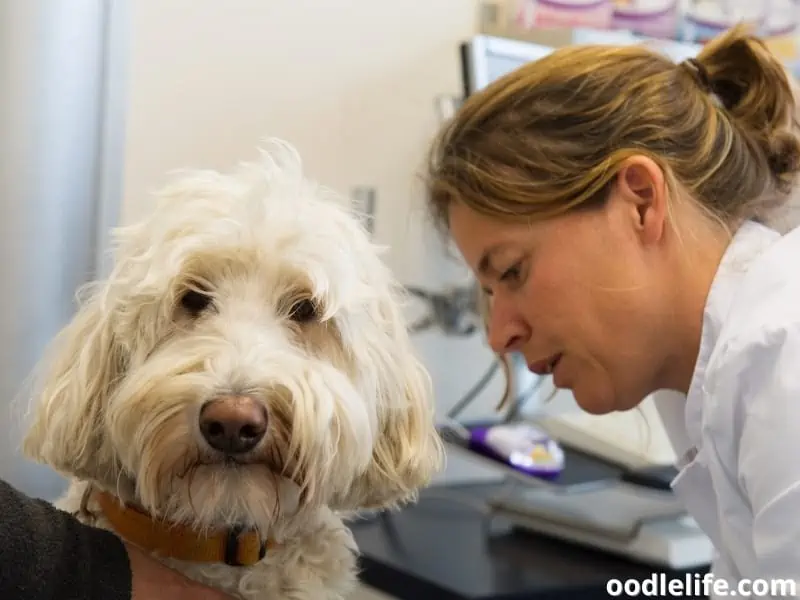Dark Spots on Dog’s Belly [What They Mean]
You’re busy with your pup spending time together, giving it some belly rubs, and you notice a couple of black spots on its tummy. You’ll probably start to wonder what the cause behind them is.
Well, black spots are usually due to hyperpigmentation, and there are many causes of this condition. This is why it is crucial to visit a vet if you notice your dog has black spots on its stomach.

Read on to learn everything you need to know about dark spots on a dog’s belly.
What Is Hyperpigmentation in Dogs?
Hyperpigmentation is the darkening or thickening of a dog’s skin. It is usually visible in lighter and hairless areas of a dog’s body, like the groin and the belly.
It’s important to understand that hyperpigmentation isn’t a disease but a reaction to other conditions affecting a dog’s skin. Hyperpigmentation in dogs is usually classified into two types: primary and secondary hyperpigmentation.
This type of hyperpigmentation is quite rare and is known to affect a few dog breeds, such as the Dachshund breed. It typically starts to become visible when a dog is a year old.
Secondary hyperpigmentation is pretty common and is often a result of many factors, such as skin allergies and infections, hormonal abnormalities, obesity, among others.

What Conditions Cause Dark Spots on Dogs’ Bellies?
As we mentioned earlier, hyperpigmentation is often a reaction or symptom of a particular condition.
Here is a closer look at some of these medical issues that cause dark spots on a dog’s belly.
Hypothyroidism
This is a medical condition (more of a metabolic disorder) whereby a dog’s thyroid glands are underactive; therefore, they don’t secrete enough thyroid hormone. And when a dog’s body doesn’t have adequate amounts of this hormone, its metabolism becomes slower.
While hypothyroidism affects almost all dog breeds, it is more common in some breeds than others.
Some breeds that are more likely to have this condition include Dachshund, Cocker Spaniels, Irish Settlers, and Doberman.
One of the symptoms of hypothyroidism is hair loss which primarily occurs at the back of the hind legs and the tail. Then, dark spots or patches begin to appear in those areas. However, this condition doesn’t cause a dog’s skin to get itchy.

Cushing’s Disease
Also known as hyperadrenocorticism, this is a medical condition whereby a dog’s adrenal glands overproduce certain hormones.
Cushing’s disease is mainly caused by a tumor in the pituitary gland. In rare cases, it may also be caused by giving a dog too much medication, particularly steroids.
This condition’s main symptoms are an unhealthy-looking fur coat and dark spots on the skin, especially the belly.
Mange
Mange is a disease caused by mites that comes in two forms: sarcoptic and demodectic mange.
Sarcoptic mange comes from the Sarcoptes scabiei mite, which is the same type of mite that leads to scabies in humans. These tiny spider-like mites burrow deep into the skin, causing intense itching. They are known to mainly target areas with no fur like the belly and armpits.
The extreme itching and licking lead to red rashes, which may later turn to dark spots and loss of fur.
Demodectic mange is caused by Demodex mites and also causes extreme licking and itching leading to open sores which may turn to dark patches. It isn’t contagious and usually affects dogs whose immune system is weak.

Yeast Infection
Also known as Malassezia dermatitis, yeast infections in dogs come from a fungus called Malassezia pachydermatis.
Usually, your dog’s skin is capable of keeping the numerous fungi and bacteria under control, thanks to its robust immune system.
However, if your animal’s immune system is suppressed or becomes weak, the bacteria and fungi on its skin may cause a yeast infection. And if the condition is chronic, it may cause your dog’s skin to have thick dark or gray patches.
Surprisingly, yeast infection in dogs isn’t contagious. But there are some dog breeds that are more prone to developing it. Among them include the Dachshund breed, Silky Terrier, Cocker Spaniel, Australian Terrier, and Chihuahua.
Allergic Dermatitis
Otherwise known as atopic dermatitis, this skin condition is caused by allergens such as food, pollens, plants, and insects.
So, if your dog is allergic to either of these allergens and comes into contact with them, its skin may have an allergic reaction. This may cause it to become extremely itchy, leading to intense scratching, rubbing, and licking, which further leads to redness and tough dark patches.

Flea Allergy Dermatitis
This is a condition caused by flea bites. When a flea sucks on your dog’s blood, it injects its saliva into its skin.
A flea’s saliva contains peptides, amino acids, and other histamine-like compounds that may trigger an allergic reaction from your dog’s immune system. It may cause your pup’s skin to become extremely itchy, leading to excessive scratching, licking, and rubbing, resulting in sores that turn to dark patches.
Epidermal Hamartoma
Epidermal hamartoma is a type of tumor found on a dog’s skin. These dark, pointy bumps are susceptible to secondary bacterial infections if you don’t treat them early. This condition is quite rare, affecting only a few dog breeds like the Cocker Spaniel.

How Do I Get Rid of Dark Spots on a Dog’s Belly?
The first thing to do if you notice dark spots on your dog’s belly is to consult a vet. As we mentioned before, dark patches or spots are a sign of underlying conditions. So, it is best to have a vet check your pet to determine the root cause of the issue.
Do dogs have belly buttons? Find out the surprising truth!
It is important to note that if the hyperpigmentation (dark patches or spots) is primary, it cannot be cured. But, if you notice it early enough, it can be improved through medications like steroid ointments.
Secondary hyperpigmentation is easy to deal with once the cause is identified. For example, antifungal and antibiotic medications can be used to treat yeast infections. Medicated shampoos can be used to alleviate itching caused by flea dermatitis, among other skin conditions, and so on.

Conclusion
Dark spots on a dog’s belly may or may not be a cause for concern. If these spots are not itchy and don’t come with other symptoms like loss of fur, then your dog may have primary hyperpigmentation.
On the other hand, if these spots are extremely itchy and your pup keeps scratching that area, it might be secondary hyperpigmentation. Again, it is essential to visit a vet to look at those spots to determine the severity of the issue and the proper medication to provide relief for your pet.